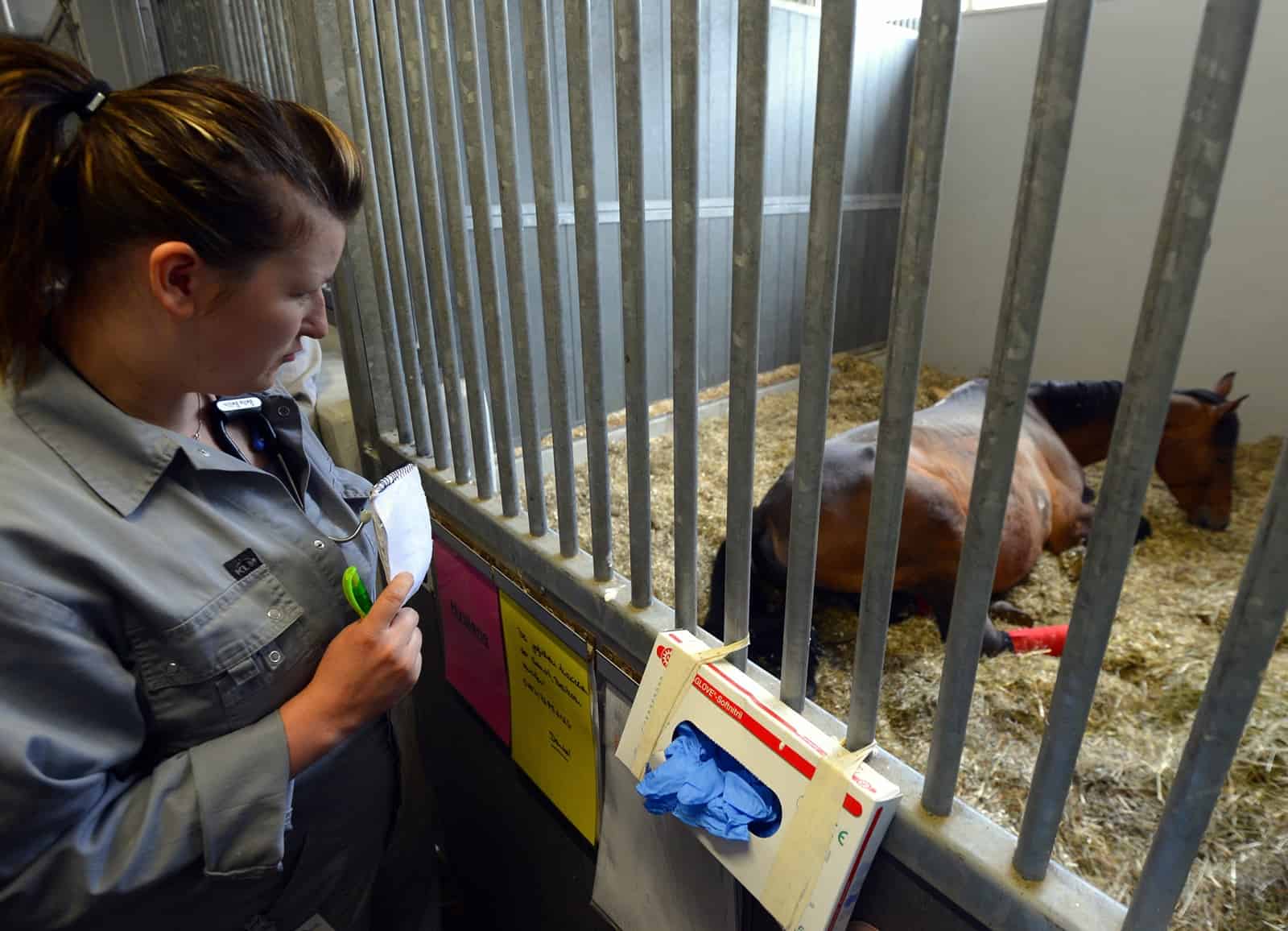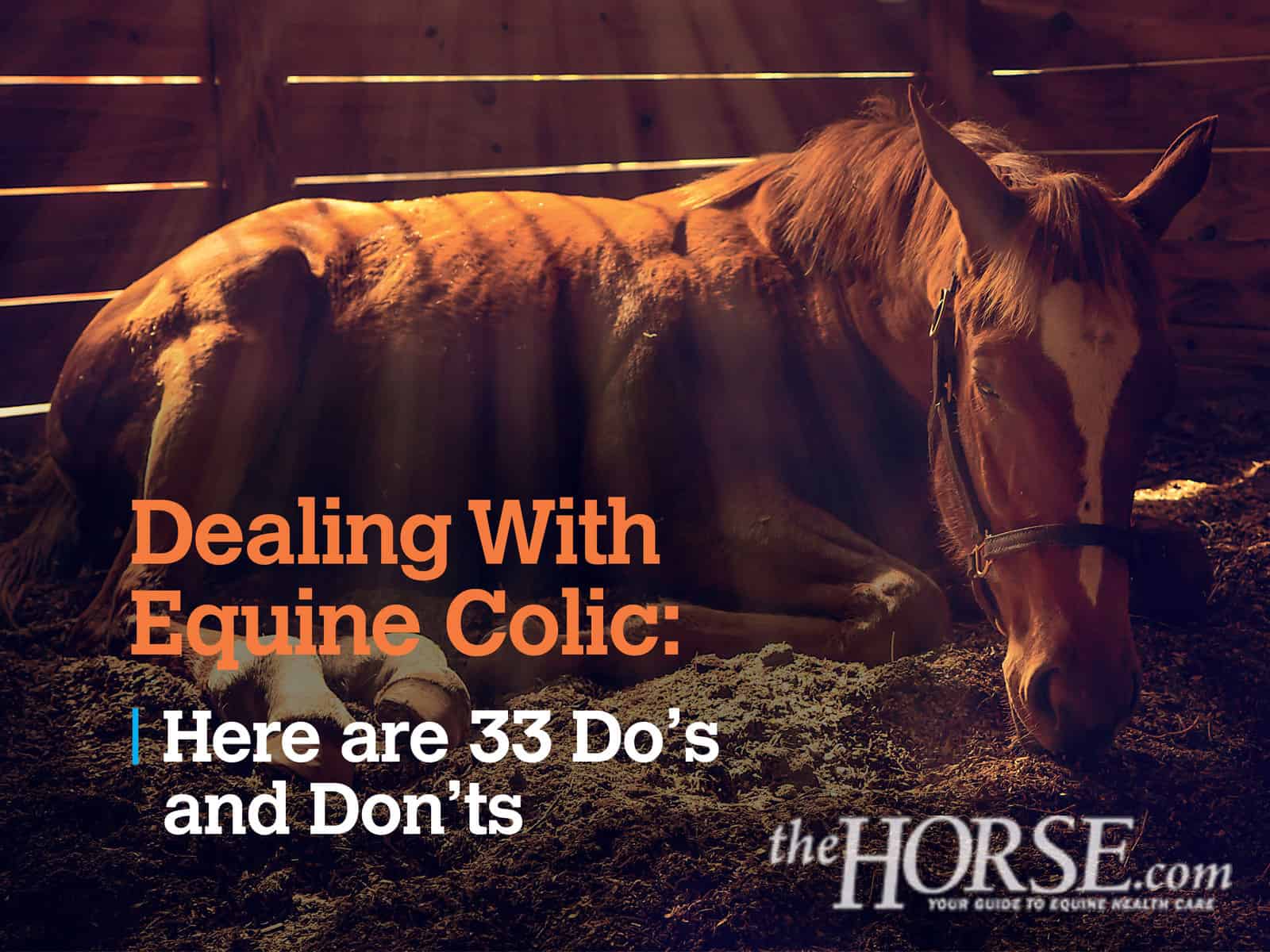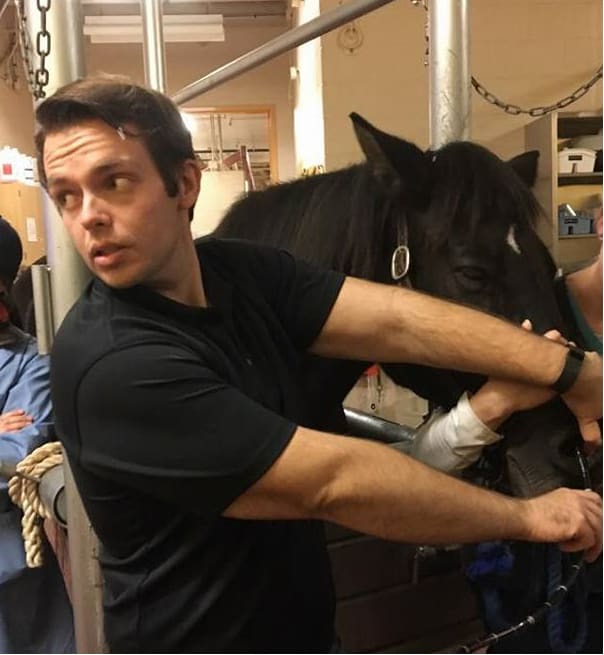What’s in Your Equine Colic Toolkit?

The things you’ll need to prevent and manage abdominal pain
Colic beleaguers its victims in a variety of ways. As an ambulatory veterinarian, I’ve seen abdominal pain compel some horses to thrash around and tear up a stall and others to stand quietly in the corner.
The severity of a colic and how we treat it depends on the individual. In this article we’ll describe what you should do to prepare in case you’re faced with a colic episode, considerations to make, and things to keep in mind if your horse makes it through surgery.
A Cell Phone
An owner’s first line of defense against a colic is not hand-walking, syringing mineral oil into the horse’s mouth, or placing an onion up the rectum (yes, I have had a client do this). It is simply a phone call to your regular veterinarian.

“Contacting your veterinarian as soon as you notice something is off with your horse is important,” says Kristen Clapp, DVM, owner of Upper Valley Equine Services, in Chester, Vermont. “I’m able to guide my clients on what to look for, what to do next, and if it’s something they can monitor or if I should come see the horse sooner rather than later.”
It’s important to remember that with colic, time is not always on your side. “Many colics, the longer you wait the worse the prognosis,” says Clapp. “Intervening early on could save everyone a lot of trouble and even be the difference in the horse making it through this colic episode or not.”
A Thermometer
Colic is such a vague term. When a call comes in for those depressed horses that are suddenly off feed, reluctant to move, and don’t want to do anything, I advise my clients to check their temperature. Colic episodes and fevers can look very similar; temperature evaluation is one clue among many when veterinarians are trying to determine what diagnostic testing and therapeutics a sick horse needs.
Some causes of sudden fever in horses include anaplasmosis (a tick-borne disease), equine herpesvirus, strangles, colitis, and peritonitis.
Fevers are good for any veterinarian to know about before getting to the farm, both for treating the horse as well as protecting others. Many febrile conditions are infectious, and any person can act as a vector. Knowing your horse has a fever will allow your veterinarian to wear proper personal protective equipment, as well as adjust their schedule to prevent incidental transmission to other barns.
NSAIDs
Flunixin meglumine (Banamine) is the most common prescription equine medication North American owners like to have on hand. While this isn’t necessarily a bad thing, it is important to emphasize the importance of how to use this medication.
“Flunixin meglumine and phenylbutazone (Bute) are part of a class of drugs called non-steroidal anti-inflammatories. Their main purpose is to stop inflammation and provide pain relief,” explains Lisanne Gallant, DVM, Dipl. ACVIM, of Newcastle Equine Centre, in Australia.
NSAIDs are beautiful and effective tools in the veterinarian’s toolbox, but they do have side effects. “The main problems associated with NSAID toxicity include gastric ulcers, right dorsal ulcerative colitis (an inflammatory reaction in the colon), and acute renal (kidney) failure,” says Gallant.
For this reason, it is incredibly important to contact your veterinarian prior to use. “These diseases can present as colic signs, lethargy, decreased appetite, diarrhea, hematuria (bloody urine), or even alterations in urine production,” she says. “Drugs like flunixin meglumine and phenylbutazone are vital to veterinary medicine. However, knowing and understanding the risks associated with their use is very important, especially when using at home as part of a first-aid kit. If you ever need to use any of these drugs, please contact your veterinarian to ensure the best outcome for you and your horse.”
Further, administering Banamine without a diagnosis or your vet’s instruction can mask the signs needed to make important management and treatment decisions, including surgical intervention.
A VCPR
Any emergency, colic included, is not the time to meet a new veterinarian. That’s why a valid veterinarian-client-patient relationship (VCPR) is so important.
“Getting to know both the horse and the owner year after year gives me the knowledge of what the horse’s health condition is, its history, and even an idea on how this horse normally reacts to pain,” says Clapp. “Is the horse a drama queen and reacts drastically to everything, or is the horse incredibly stoic and signs of showing pain are truly bad news? For example, and I say this with love, my husband being sick and me being the same level of sick are way different!”
Further, at many practices a VCPR can affect whether a veterinarian can even see an emergency. Many equine practitioners have solo practices, meaning they work alone and cover their own emergencies.
“I try my hardest not to decline seeing an emergency, but my practice radius is very large and I am only one person,” explains Clapp. “If I am in a jam where two things are going on at once in separate directions, I have to give my regular clients priority.”
This is an easily preventable reality. Establish a working relationship with a local veterinarian to guarantee coverage for you and your horses.

The Ability to Haul
Horse owners operate in social circles. Chances are, if one does not have a trailer, they have a friend down the road who’s willing to help in an urgent situation. For those who don’t have access to a trailer, having contact information for a local hauler is a great idea. These companies are common throughout the country and often available for emergency transport.
A Referral Plan
An important consideration to make prior to a colic is what you would do if your veterinarian recommends referring the case to an equine hospital. “I always advise my clients to have predetermined how far both financially and emotionally they can go with their horses,” says Clapp.
While many colics recover in the field, a handful do best at a referral hospital. Hospitals are not just for surgery; horses whose pain cannot be controlled on the farm are great candidates for referral, and those with severe impactions that could benefit from the use of intravenous fluids can pull through without a scalpel.

Often, the biggest hurdle to referral is the owner’s finances. This is a real problem for many clients, which is why veterinarians prefer to discuss their ability to refer prior to an emergency. In my experience, having a horse insured can significantly alleviate the financial impact on the owner. Investigate which companies offer equine insurance in your area. Having a preset plan and sticking to it can help avoid some tragic circumstances.
“I have been in many situations where clients will say it is not an option to refer and ask me to do everything I can on the farm,” says Clapp. “Then hours later decide they would like to take the horse to surgery. Getting the phone call from the surgeon that too much bowel has been compromised or something has ruptured requiring euthanasia on the table is always heartbreaking for me.”
A hesitation I hear from my own clients about sending their horses to surgery is that the horse is forever at risk of repeat colics.
“If your horse has made it out of the hospital after colic surgery, it has a good chance of living a normal life,” says Dustin Major, DVM, Dipl. ACVS, a surgeon at Loomis Basin Equine Medical Center, outside Sacramento, California. “Studies show that if the horse makes it to one-year post-op without experiencing any more colic signs, its chances of future colic and the need for colic surgery are essentially no different than the horse population in general.”
Rehab Following Colic Surgery
Sometimes, surgery is inevitable. Conditions such as lipomas (benign fatty tumors), unresolving displacements, or continued immense pain are indicators for colic surgery. Major describes what recovery typically looks like after colic surgery: “The horse is usually in the hospital for three to seven days, depending on the amount of postoperative care needed and how quickly we are able to refeed the horse.” (It’s important to introduce forage and feed slowly after surgery as the GI tract regains normal motility.)
Usually, the horse wears a bandage over the incision until hospital discharge, at which point “minimal incisional care should be necessary—primarily inspecting it for any heat, swelling, pain on palpation, or discharge,” he says. “The majority of horses do not require any sort of bandaging beyond discharge from the hospital, the exception to this being horses that have had any signs of incisional infection or other complications, as these issues increase the risk of the development of an incisional hernia.”
A Clean Stall or Confinement Area
Whether your horse has been discharged from surgery or has simply suffered a gas colic at home, your ability to confine him is incredibly important. When I initially see a horse for colic, nine times out of 10 I’ll advise the owner to withhold feed for a period. That is easiest when the horse is kept in a stall. I can also monitor any manure the horse has produced—an all-too-common part of the glamorous job of an equine veterinarian.
Housing and management following surgery, however, are more complicated. Horses can’t simply be turned out with the rest of the herd and often must spend a significant time in a stall.
“Most surgeons follow the 30-60-90 rule for rehabilitation,” explains Major. “Basically, the horse is kept in a stall with some degree of hand-walking for 30 days postoperatively, then in a small paddock for another 30 days, then regular turnout in whatever capacity the owner wishes for a final 30 days. The horse is then ready to begin a gradual return to work at the end of this 90-day period.”
It’s important that your horse tolerates stall rest for an extended period. You might consider products on the market to assist in his recovery, such as slow-feeding haynets, treat toys, and sedatives.
Complications occur when the owner doesn’t have access to a stall or small pen. In these cases owners can use grazing muzzles to limit the amount of food the horse can freely eat and set up portable panels to prevent the horse from moving around so much that he stresses the abdominal tissues and risks getting a hernia.
Take-Home Message
In some horses and situations colic can be impossible to prevent. These tools, however, will help you best handle colic if it comes knocking at your stall door. Do not attempt to handle an episode alone. Vets are a phone call away and happy to help guide you through a scary situation.

Written by:
Chris White, DVM
Related Articles
Stay on top of the most recent Horse Health news with











